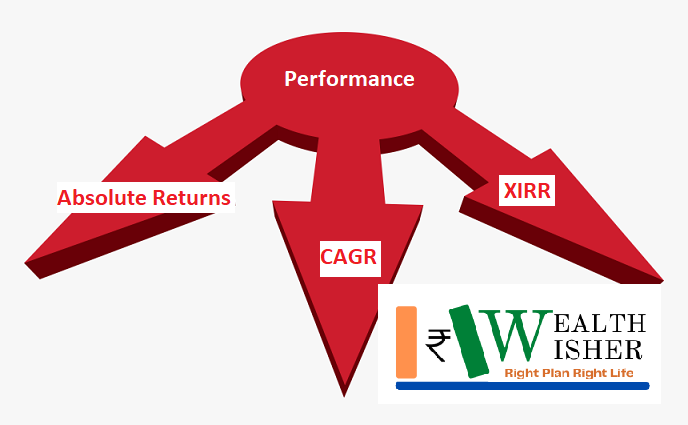You must have come across multiple terms to calculate Mutual Fund or investment performance such as Absolute Returns CAGR XIRR. Today let’s understand the difference between them and their relevance to your mutual fund portfolio.
ABSOLUTE RETURN
What is Absolute Return?
Absolute Returns, also called Total Returns, help us in calculating how much gain or loss you have made on your investment.
We use absolute returns when we want to showcase a simple point-to-point return where the holding time is generally less than a year.
In fact, the time element is absent when we use absolute returns for eg returns calculated from Jan 1, 2021, to 17 Sept 2021. There is no annual calculation so it cannot be compared with another time frame.
To calculate, you only need to know the initial and the current or the ending value of the investment scheme
Absolute Returns = (Ending Value – Initial Value) / Initial Value * 100
So if an investor started with Rs 100000 and he got Rs 120000 his Absolute returns will be E.g. (1,20,000 – 1,00,000 / 1,00,000) * 100 = 20%.
Note there is no time reference that he got 20% in one year or in 5 years? So you cannot compare this with other investments.
COMPOUNDED ANNUAL GROWTH RATE or CAGR
What is the Compounded Annual Growth Rate (CAGR)?
CAGR or Compound Annual Growth Rate helps you gauge the average yearly growth of your investments over a specific time period. It contains the assumption that investment is compounded over time.
CAGR is a relevant ratio to assess a lumpsum investment. You can use these returns to evaluate how your mutual fund investment is performing among parity schemes, against benchmark or other avenues such as bank deposits.
It just requires three inputs; an investment’s beginning value, ending value and the period.
The formula to calculate CAGR is:
CAGR (%) = (Ending investment value / Beginning Investment Amount) ^ (1/investment tenure in years) – 1
There are some limitations to CAGR:
- CAGR assumes that the same rate return will apply throughout the investment time.
- The returns do not take into account mid-term contributions or withdrawals.
- It does not help calculate returns for periodic investments like SIP.
Hence the best method is to calculate XIRR.
EXTENDED INTERNAL RATE OF RETURN or XIRR
What is the Extended Internal Rate of Return (XIRR)?
XIRR stands for Extended Internal Rate of Return, a method used to calculate returns on investments. XIRR is that single rate of return, which would give the current value of the investment when applied to every installment (and redemptions if any).
It is your personal rate of return as it calculates your actual return on investments considering all installments & withdrawals.
In real life, the investments & redemptions happen over a different period, and in such a scenario, CAGR may not be applicable to calculate the returns. If you are investing through SIP or lumpsum or redeeming through SWP or lumpsum, XIRR is the appropriate way to measure returns.
You can think of XIRR as nothing but an aggregation of multiple CAGRs. If you make multiple investments in a fund, you can use the XIRR formula to calculate your overall CAGR for all those investments taken together.
XIRR can be easily calculated using Microsoft Excel. Excel provides an inbuilt function to calculate XIRR.
XIRR formula in excel is:
= XIRR (value, dates, guess)
An example to show the difference between Absolute Returns CAGR XIRR
Suppose you made a SIP of Rs.10,000 every month for eight months into Scheme A starting from April 01, 2020, to Nov 01, 2020.
And you wish to redeem on Nov 24, 2020. Assuming NAV on the date of redemption is Rs.39.48.
Thus, the value of your investment = Total No. of units X NAV at the date of redemption = 2508.02 X 39.48 = Rs.99,017.
Let’s calculate all 3 types of returns – Absolute Returns CAGR XIRR.
Absolute Return
= (Ending Value – Initial Value) / Initial Value * 100
= (99017-80000) / 80000 * 100 = 23.17%
CAGR
CAGR (%) = (Ending investment value / Beginning Investment Amount) ^ (1/investment tenure in years) – 1
(99017 / 80000) ^ (1/0.67) -1 = 37.67%
XIRR (with excel)









